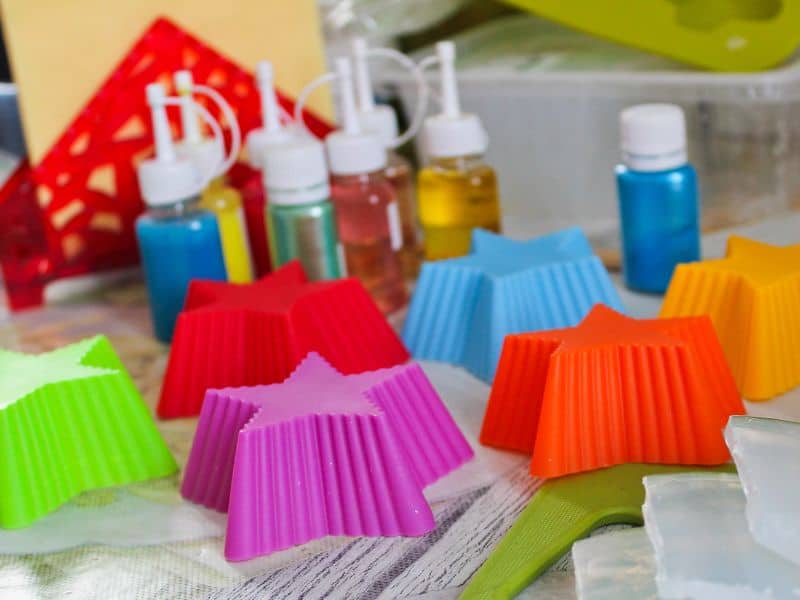Cold-process soap is an incredibly popular way of making soap from scratch. It involves combining oils and lye, which then goes through a saponification process to create the soap. You can add different additives and colorants to achieve different results. In this blog post, we will discuss how much colorant you need to use in cold-process soap in order to get the desired effect.
Colorant in cold process soap should keep a ratio of approximately 1 teaspoon of colorant to 1 tablespoon of lightweight oil. For larger batches, you can increase the proportion of colorant to oil accordingly – for example, 2 teaspoons of colorant to 2 tablespoons of oil, or 3 teaspoons to 3 tablespoons.
Let’s go over the basics of cold-process soap. Cold-process soap is made by mixing together various types of oils and lye. The combination of these two ingredients creates a type of chemical reaction known as saponification, which creates the base for your soaps. You can then add additional ingredients like colorants or essential oils to achieve different effects with each batch you make.
Types of Colorants for Cold Process Soap
When it comes to colorant, there are a few options available when making cold process soaps: mica powder, pigments, and natural plant material such as herbs and fruit peels. Mica powder is a very fine powder that gives off beautiful shimmery colors; pigments come in both liquid and dry form and are more vibrant than mica powders; while natural plant materials offer interesting visual elements but can be difficult to measure precisely due to their varying densities.
Cold Process Soap Color Options
When it comes to adding colorants to cold-process soap, there are a number of different options. You can use dyes, pigments, micas, and other colorants to get a variety of different shades. Let’s take a closer look at some of these options.
Liquid Dyes
Liquid dye is an easy-to-use dye that can be added in small amounts to create a variety of colors. They are generally safe for use in cold-process soap, though it’s always best to test out the dye on a small batch before committing to larger batches.
Natural Colorants
You can also use natural colorants like clays, spices, and herbs to add a variety of shades to cold-process soap. Natural colorants are often more muted than dye-based colorants and require larger amounts to achieve the desired effect.
Micas
Micas are a type of dye-based colorant that is best suited for cold process soap. They provide a shimmery, iridescent effect and come in a variety of shades.
Pigments
Pigments are a dye-based colorant that is best for creating bright, vibrant hues. They can be added in larger amounts than dye and micas to get the desired effect.
Estimating How Much Colorant Is Needed for One Batch of Soap
The amount of colorant needed for one batch of soap depends on several factors such as the size and shape of your mold, the desired depth of color obtained, and the type of colorant used.
Generally, 0.25 – 2 teaspoons (1- 8 grams) per pound (454g) is recommended when using mica powder or pigment/liquid dye/soap dye respectively as too little will not affect your color at all whereas too much could result in an unnaturally bright hue that could stain fabric if used on towels or other laundry items being washed with your soapy creations!
When using natural plant materials such as herbs or fruit peels you’ll want to experiment with small batches first before committing to a full batch! This way you can get your perfect shade without wasting any ingredients or having an overly vibrant color appear after finishing up your creation!
Tips on Adding Different Types Of Colorants To Achieve Desired Results
Adding colorants into cold process soaps can be tricky since they have such intense hues that won’t blend well if added directly into finished products! To avoid this issue try pre-dissolving any liquids/pigment dyes into melted oils before fully incorporating them into your recipes – this ensures even dispersal throughout!
For mica powder, you’ll want gently mix it into melted oils with either a lollipop stick or palette knife until blended before pouring it into molds! When using natural plant material steep them in hot water overnight beforehand before straining out stems & leaves then adding the resulting infusion directly into your recipe!
Cold Process Soap Curing & Storage
Curing Cold Process Soap
Once a cold-process soap is made it should be allowed to cure for 4 – 6 weeks before use. This allows the saponification process to complete and ensures that your soaps are mild and gentle enough for use on the skin.
Remember, 4-6 weeks is a good starting point but this time will also depend on how wet you made the soap and how large your soap mold is. It could take longer or go a little quicker. You are going to have to experiment and work your way through it the first couple of times.
Cold Process Soap Storage
To ensure your soaps last longer, store them in an airtight container away from direct sunlight or heat. How you wrap and package the soap can also play an important role in how you store it.
Wrapping each soap bar in parchment paper or wax paper will keep the bars from sticking to each other and help maintain their scent. For longer-term storage, wrap the bars tightly in plastic wrap or tuck them inside a sealed container such as a mason jar.
Proper storage prevents your soaps from losing any of their colorants over time!
Frequently Asked Questions
No, cold-process soap is actually fairly simple to make. With the right ingredients and tools, you can create beautiful soaps with ease!
The amount of dye or pigment used will depend on the desired depth of color, and can range from 0.25-2 teaspoons (1-8 grams) per pound (454g). For liquid dye, it is best to test out dye on a small batch before committing to larger batches.
The best types of colorants for cold process soaps are liquid dye, mica powder, pigments, and natural plant materials. Each one will provide different shades and effects, so you will want to experiment with small batches first before committing to a full batch.
Generally, dye-based colorants are safe for use in cold process soap. However, it is always best to test out dye on a small batch before committing to larger batches.
Conclusion
Knowing how much colorant should be used in cold process soap is important if you want consistent results every time you make batches! Depending on what type (whether it be mica powders, liquid dyes/pigment dye etc.) will influence how much should be used per individual batch – generally 0.25 – 2 teaspoons (or 1-8 grams) per pound (454g) would suffice when using these types!
If using herbal infusions or natural plant material though do test small batches first before committing yourself completely as their density makes measuring difficult & unpredictable shades may occur once finished curing!
With the right amount of dye, pigment, or mica powder you can achieve beautiful, consistent results every time when making cold-process soaps! So experiment and have fun with your creations!






